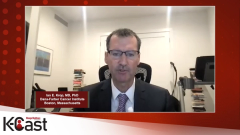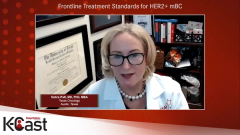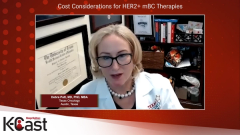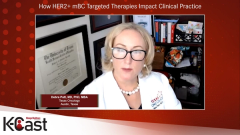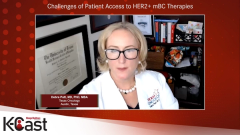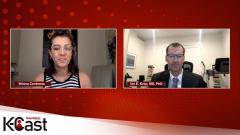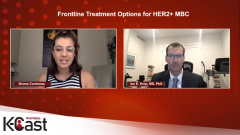
New Targeted Therapies for HER2+ mBC
An expert in HER2-positive metastatic breast cancer discusses the new targeted treatment regimens for patients.
Episodes in this series

Briana Contreras: Next, we’ll be looking beyond chemotherapy in HER2+ [human epidermal growth factor receptor 2 positive] metastatic breast cancer. For the first question, what are some of the newer targeted approaches that you have incorporated into practice?
Debra Patt, MD, PhD, MBA: It’s actually been a year of discovery in HER2+ metastatic breast cancer. We’ve had a lot of different therapeutic innovations that have been incredibly useful. You can think of them categorically as sort of your antibody drug conjugates, and then your targeted therapies that have been really useful. We’ve seen tucatinib in combination with trastuzumab and capecitabine enter into the market with the HER2CLIMB [trial]. That study has been incredibly beneficial, especially for women with brain metastases. [It is] very encouraging in this patient population that has a higher predilection for central nervous system metastases. We’ve seen neratinib move forward as a viable therapeutic target to target the HER2 family; that’s been effective. We’ve seen T-DXd, or trastuzumab deruxtecan, evolve as an appropriate therapeutic intervention that is highly efficacious. We’ve seen margetuximab enter the market. We’ve seen more therapeutic interventions in the HER2+ space this year than in any other year. I think that it doesn’t alter frontline choices at this moment, though it may because some of these agents are really effective. Putting them as frontline treatment may be an option that is currently under investigation. But it does make it more complicated to make treatment decisions after first-and-second-line therapy when you look to subsequent line of therapy choices because there are many innovator products in that space.
Briana Contreras: When should targeted approaches be used in the metastatic setting?
Debra Patt, MD, PhD, MBA: I think targeted approaches should be used in every line of therapy when they can be. We know that chemotherapy and endocrine therapy act best when they are in combination with HER2 blockade. In my opinion, always combining those strategies with HER2 blockade, when that’s felt to be safe, is a more effective treatment strategy. It’s interesting that you bring this up, because I have been on peer-to-peer reviews of prior authorization where other doctors that are not oncologists have come on the phone, and said if the patient has progressed on trastuzumab, they shouldn’t have trastuzumab again. Obviously, it was not an oncologist, because that’s an indicator that the patient should always have a backbone of HER2 blockade as long as that backbone of HER2 blockade can be given safely in combination with the other therapeutic intervention. For example, you would not combine doxorubicin with a HER2 blockade, because we don’t believe that that’s a safe strategy. But when it’s a safe strategy, we always believe that either endocrine [therapy] or chemotherapy should be accompanied by a HER2 blockade backbone.
Briana Contreras: What are the considerations for deciding which targeted therapy is appropriate for a given patient?
Debra Patt, MD, PhD, MBA: I think it’s very patient-specific. What have they seen? What have they progressed on? How long they were on it? Are there brain metastases? What do we know about penetration into the central nervous system? That’s a nuanced decision, each time you make it, for each subsequent line of therapy.
Briana Contreras: Thank you. What is the rationale for the use of dual HER2-targeted monoclonal antibody therapy?
Debra Patt, MD, PhD, MBA: That’s a great question. I would say upfront, the regimen of docetaxel, pertuzumab, and trastuzumab is highly efficacious. We generally always use that in combination with dual HER2-targeted therapy. In other regimens, when we are looking at multiple targets, such as the HER2CLIMB regimen, for example, those are also beneficial when they are given in combination. I would say in the absence of those 2 examples generally speaking, people are using HER2 blockade as single agents in combination with another treatment strategy or alone.
Briana Contreras: Thank you. What are the data that led to the incorporation of dual HER2-targeted therapy as part of the current treatment landscape for metastatic disease?
Debra Patt, MD, PhD, MBA: Really looking at the efficacy of docetaxel in combination with trastuzumab and pertuzumab. This is a highly effective strategy. Not only is the trial data compelling, but I think now that we have had these drugs in this space for such a long period of time, many of us in our own practice have many patients that are more than 5 years into their initial therapy on docetaxel in combination with trastuzumab and pertuzumab. When they had some toxicity with docetaxel, the oncologist sunsetted the docetaxel and continued the patient on trastuzumab and pertuzumab, which they have continued on targeted therapy with or without endocrine therapy depending upon the patient and the doctor’s choice. But they have enjoyed prolonged disease-free intervals of many years; I think that that’s incredibly compelling.
Briana Contreras: Thank you. Can you please describe some of the issues surrounding administration of dual HER2 therapy in the metastatic setting and the need for convenient and effective approaches? For example, treatment schedules, COVID-19, and patient concerns.
Debra Patt, MD, PhD, MBA: I would say that many of these therapies, especially as it pertains to trastuzumab and pertuzumab, can be given at 21-day intervals and that’s really useful. Generally speaking, that’s convenient for patients. When you are also cycling other therapies that may be pertinent to patients with metastatic breast cancer, like for example, bone health agents, like zoledronic acid or estrogen blockade with fulvestrant, or ovarian suppression, sometimes people do consider alternate schedules of these therapeutic interventions to try to keep treatment more convenient for the patient. Understanding the half-life of some of these therapies; I think that many of us can make those informed choices in reasonable ways. For example, I always treat patients on a 3-week schedule of trastuzumab and pertuzumab when I’m treating them in the metastatic setting. However, I have a patient that fell into my practice who was on, for 9 years now, a combination of fulvestrant in combination with trastuzumab. She’s taken on a 4-week schedule for 9 years and continues to be in complete remission for 9 years. Obviously, that’s an effective strategy which combines a reasonable way to block HER2 in combination with estrogen blockade that’s been incredibly convenient for the patient. She has continued to work and travel and do all the wonderful things in her life. Again, I think that the guidelines about how we administer treatment are incredibly important, but it doesn’t supplant the need for clinical decision-making about what’s right for a patient. Those are choices really made between doctors and patients.
Transcript edited for clarity.
Newsletter
Get the latest industry news, event updates, and more from Managed healthcare Executive.

